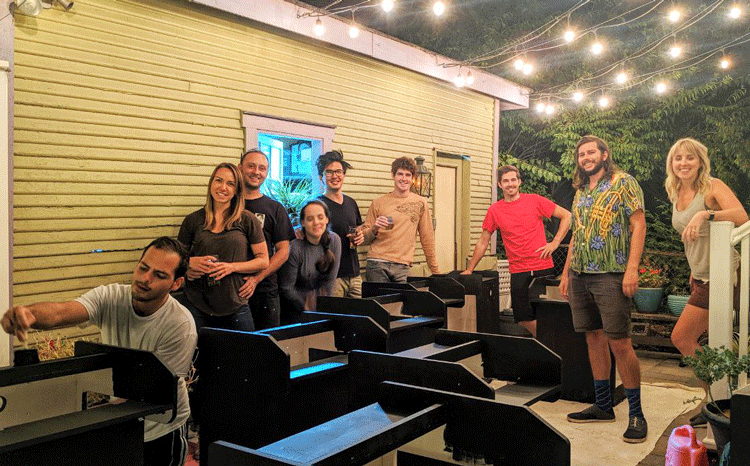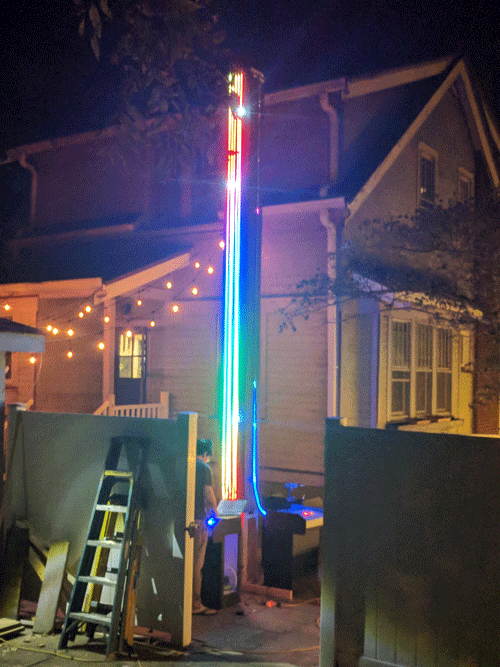
Computer Science Graduate Is the Brains Behind BLINK Display
May 6, 2020
While he was vacationing in sunny Barcelona last October, Brian Bailey’s team was in Cincinnati’s Washington Park working hard to make sure the 20-foot towers of LED light strips and video games they had spent months creating actually worked for the thousands of visitors at the city’s four-day event called BLINK.
Their project was not like most of the other BLINK displays. While most displays were intricate light show projections on the walls of city buildings throughout downtown, theirs included tall black towers of lights that raced like rockets 16 feet to the top with an arcade pedestal, joy stick and buttons to control the lights. There was a Pong game on a 12-foot table with eight light strips and a button on a pedestal to control the light dots, and a third game where players could change the color scheme of a light simulation.
Bailey, a 2013 Computer Science graduate, was the brains behind the unique BLINK display. As the lead software architect, he figured out how to program and wire the system to produce the three different games that visitors could play. The project was so different and well-planned that the BLINK organizers awarded the team, Kemper Sauce Studios, the full $7,000 grant to build it.
Bailey says he owes the project’s success to Xavier’s Computer Science professors, who taught him how to think, strategize and solve problems.
“I was able to pick apart our architecture and figure out that we needed multiple processors, otherwise we wouldn’t have completed the display,” he said. “One of the best ways (Xavier) prepared me was giving me the general ability how to learn computer science. They don’t spend time teaching you the new language. They teach you the new concept which will force you to learn the new language—to learn how to learn. That always kept me ahead of the curve.”
Bailey, who works as a software engineer for Shoptech Software in Cincinnati, got involved when two friends invited him to help develop the project and pitch it to BLINK.
“They had an idea to build old-school arcade cabinets with LED light strips and microprocessors, but they didn’t know how to execute the software aspect of it,” Bailey said. “Knowing we were making multiple games, I knew we needed a common framework for the game architecture and design work and then figured out what worked and what looked visually good, so we went through a lot of ideas and threw out a lot, too.”
Because he was trained in the theory, architecture and methodology for building software applications, he joined the team, which soon grew to four, and pitched the bid to BLINK organizers. He was surprised when they were awarded the full $7,000 grant. The money was used to purchase around 30 microprocessors, hardware, computer chips, lumber and paint, and six miles of LED strips. They spent six months, from April to October, developing, building, testing and fixing the games. In the end, they had about 17 people they recruited to help finish construction.
Bailey wished he’d been able to attend, of course, but the trip to Spain had been planned before he knew about the project. And even though they did not win the BLINK award for best display, the results exceeded their expectations as theirs was one of the most popular.
Stationed near the gazebo in Washington Park, people streaming by stopped to watch or stood in line for a chance to play. Bailey was especially proud when their display was featured on a TV news report about BLINK which featured children from Children’s Hospital playing their games.

“I watched the news report and this woman came up and showed the kids how to play the game, and it was my mother!” he said. “It was really heart-warming to see these were kids from Children’s Hospital, and they came out and interacted with our piece. Another thing that stood out was that a couple who were big video game fans got married in front of our piece in the gazebo.”
Bailey was preparing for his computer career all his life, even if he didn’t know it. When he had trouble concentrating in elementary school, he was tested and admitted to Covington Latin High School, where he was allowed to skip two grades and placed in the ninth grade.
He started Xavier as a freshman physics major when he was 15, which he said was a “weird” experience being with peers who were three years older than him. After taking a year off school, he began attending part time and at nights while also working and completed his degree nine years later. He also switched his major to Computer Science because, he said, it’s a more exact science.
His first real job, however, was an internship he had while at Xavier that became a full-time job when he graduated. He has since worked for three other local companies, including Great American Insurance, where he was a software developer.
He became close to his professors at Xavier and began attending an annual alumni event with them at Listermann Brewing near campus, including one last fall. They talked about his team’s BLINK project, which has caught the attention of other festival organizers interested in paying for the display.
“I was able to point to all of them and tell them they personally had given me knowledge that saved our project,” he said. “The Xavier experience in Computer Science is you learn a lot of important technical and theoretical things, but also it’s the environment where if you’re doing a side project, you can always talk to your professors. I spent lot of time in their offices talking about things. They were such valuable resources for me.”
By France Sloat, Office of Marketing and Communications
Feature Image: Brian Bailey, on the right in flowered shirt, and his BLINK team